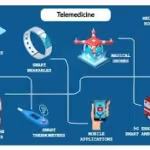Telemedicine is a rapidly evolving field that leverages technology to deliver healthcare services remotely. By facilitating communication between patients and healthcare providers without the need for in-person visits, telemedicine enhances access to care, improves efficiency, and optimizes healthcare costs. This comprehensive exploration will delve into the definition of telemedicine, its accessibility, efficiency, cost-effectiveness, technology integration, effectiveness, and practical examples.
Definition of Telemedicine
Telemedicine encompasses the use of telecommunications technology to provide medical care, education, and information from a distance. It includes a variety of services such as:
- Remote Consultations: Patients can interact with healthcare providers through video conferencing, phone calls, or messaging.
- Monitoring: Healthcare professionals can track patients’ health metrics using wearable devices or mobile applications.
- Education: Telemedicine can facilitate health education and training for both patients and healthcare providers.
Overall, telemedicine aims to bridge the gap between patients and healthcare providers, making medical care more accessible and efficient.
Accessibility
Enhancing Access to Care
One of the most significant advantages of telemedicine is its ability to enhance accessibility to healthcare services. This is particularly beneficial for:
- Rural and Underserved Areas: Many individuals living in remote locations face challenges in accessing healthcare facilities. Telemedicine allows them to consult with specialists without the need to travel long distances.
- Mobility Issues: Patients with disabilities or chronic conditions may find it difficult to visit healthcare facilities. Telemedicine provides a convenient alternative, allowing them to receive care from home.
- Busy Lifestyles: For individuals with demanding schedules, telemedicine offers flexibility, enabling them to fit medical appointments into their day without the need for extensive travel time.

Expanding Reach
Telemedicine also expands the reach of healthcare providers. Specialists can offer their services to patients in various locations, thereby increasing their patient base and contributing to improved health outcomes across diverse populations.
Efficiency
Streamlining Healthcare Processes
Telemedicine significantly enhances the efficiency of healthcare delivery. By reducing the need for in-person visits, it streamlines processes such as:
- Appointment Scheduling: Patients can schedule appointments more easily through online platforms, reducing administrative burden.
- Reduced Wait Times: Virtual consultations often have shorter wait times compared to traditional office visits, allowing patients to receive timely care.
- Follow-Up Care: Telemedicine facilitates quick follow-ups, enabling healthcare providers to monitor patients’ progress without requiring them to return to the office.
Improved Resource Management
Healthcare facilities can better manage their resources by utilizing telemedicine. With fewer patients needing to be physically present, providers can allocate staff and equipment more effectively, leading to improved overall efficiency.
Cost-Effectiveness
Lowering Healthcare Costs
Telemedicine can reduce healthcare costs for both patients and providers. Key factors contributing to cost-effectiveness include:
- Reduced Travel Expenses: Patients save on transportation costs and time by avoiding unnecessary travel to healthcare facilities.
- Lower Overhead for Providers: Healthcare facilities can reduce overhead costs associated with maintaining physical office space and managing patient traffic.
- Preventive Care: By providing easier access to healthcare services, telemedicine encourages preventive care, which can lead to cost savings by reducing the need for more expensive treatments down the line.
Insurance Coverage
Many insurance providers are beginning to cover telemedicine services, further enhancing its affordability for patients. As telemedicine becomes more widely accepted, it is likely that coverage will expand, making it a more viable option for a broader range of individuals.
Technology Integration
Utilizing Advanced Technologies
Telemedicine relies on various technologies to facilitate remote healthcare delivery. Key components include:
- Video Conferencing: Platforms such as Zoom, Skype, or dedicated telemedicine software enable real-time consultations between patients and healthcare providers.
- Mobile Health Applications: These apps allow patients to track their health metrics, communicate with their providers, and access educational resources.
- Wearable Devices: Devices such as smartwatches can monitor vital signs and send data to healthcare providers for ongoing assessment.
Electronic Health Records (EHRs)
The integration of EHRs with telemedicine platforms enhances the continuity of care. Providers can access patients’ medical histories, treatment plans, and test results during virtual consultations, ensuring informed decision-making.
Effectiveness
Improved Health Outcomes
Numerous studies have demonstrated the effectiveness of telemedicine in improving health outcomes. Key benefits include:
- Chronic Disease Management: Telemedicine allows for regular monitoring and management of chronic conditions such as diabetes, hypertension, and asthma, leading to better patient adherence to treatment plans.
- Mental Health Services: Teletherapy has gained popularity, providing patients with access to mental health professionals and reducing stigma associated with seeking help.
- Emergency Care: Telemedicine can facilitate timely interventions in emergency situations by connecting patients with specialists who can provide guidance before they reach a healthcare facility.
Patient Satisfaction
Patient satisfaction is a crucial indicator of healthcare effectiveness. Many patients






